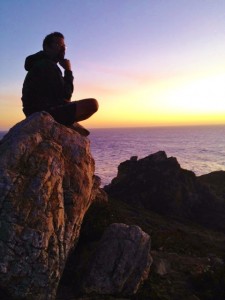 During the past few weeks, I have posted thoughts at the intersection of Zen and Advaita Vedanta. Here I offer the first of several blogs that I will simply call “Zen Thoughts,” though much of what I have to say reflects the non-dual tradition of Advaita Vedanta.
During the past few weeks, I have posted thoughts at the intersection of Zen and Advaita Vedanta. Here I offer the first of several blogs that I will simply call “Zen Thoughts,” though much of what I have to say reflects the non-dual tradition of Advaita Vedanta.
I begin with three quotes from Zen master Dogen.
“Between aspiration, practice, enlightenment, and nirvana, there is not a moment’s gap.”
“Great enlightenment is the tea and rice of everyday living.”
“Beyond enlightenment is the jewel concealed in your hair.”
In the first statement Dogen affirms the non-separateness of the Path and the Goal. In the second he tells us that what we are looking for in the way of spiritual attainment (Path and Goal) is our present reality. In the third he makes the same point, with the suggestion that we need to “get over” enlightenment as a goal.
Below I explore Dogen’s wisdom. The first section is a series of statements about enlightenment as our present reality, the mental conditions under which this present reality is obscured, and human suffering. The second section is a series of statements about zazen, so-called “Zen meditation.”
I offer these thoughts not simply from an intellectual standpoint but as children born from me through zazen practice during the past few months. Ultimately, of course, Zen insight cannot be adequately captured through thoughts or words. You must deeply dive into your experience.
Enlightenment as the Veiled Present Reality
1. The greatest challenge in the search for enlightenment is finding the path that leads to it, and the greatest challenge in the search for the path to enlightenment is realizing where you are at present. The path you are seeking is actually where you are in your present condition, and the light you hope to find at the journey’s end is already your present reality. It is shining as your essential Self.
2. The mind veils the Dharma (truth), so it is not seen as your present reality. The mind veils the Path, so it is not seen as the ground where you are already standing and upon which you already walk. The mind veils the Self, so that it’s seen to be different from the Dharma and the Path.
3. What is the veil? The veil is the belief and subsequent feeling that I am this self, this person, that what I essentially am shares in the limits and destiny of the mind-body. Being this self, I am separate from other things. Being separate from other things, aversion and clinging to them arises. In short, the veil is the mind’s story. The central character is the “I-thought” and the plot is the search for enlightenment, intermittently suspended by brief moments of peace in an on-going cycle of clinging and aversion.
4. Ramana Maharshi said, “When the I is divested of the I, only the I remains.” Here the Big Mind of Zen meets the Abiding Awareness of Vedanta. Enlightenment, therefore, may be described as a subtraction: the falling away of the small mind, the dismantling of the false ego, the dissolution of what we take ourselves to be.
5a. The present reality is the perception of the butterfly landing on a leaf, the sound of a passing car, the taste of cashew butter, the smell of oranges, the softness of the cat’s fur as your hand glides upon its back – all an expression or manifestation of life as it is, without judgment, without reaction. You are that.
5b. The present reality is the perception of the lifeless body of a bird, the screeching sound of nails upon a chalk board, the sourness of a lemon, the smell of rotting meat, and the prick of a thorn that penetrates your skin – all an expression or manifestation of life as it is, without judgment, without reaction. You are that.
5c. The present reality is your struggle, your depression, your anxiety, your sadness, your pain, your suffering. It’s the impermanence of things; indeed, it’s the no-thingness of things. You are that.
6. The greatest obstacle in the search for enlightenment is searching for enlightenment, because in this search you might miss the chair sitting in your room.
7. Don’t worry about enlightenment. It will find you, and there’s utterly nothing you can do to prevent it. You may be taking a shower, drinking tea, or brushing your teeth. You may be reading a novel, conversing with a friend, or watching a cat walk along a fence. You may be laughing, crying, or sleeping. Enlightenment will find you.
8. Enlightenment is like breathing. It’s present and happening all the time but just not noticed.
9. I like this “pleasant” experience. Attachment to it arises. Suffering is invited. I dislike this “unpleasant” experience. Aversion to it arises. Suffering is experienced.
10. Unhappiness is nothing less and nothing more than the search for happiness, but the substance of all unhappiness is the very enduring peace we wish we had instead.
On Zazen (“Zen Meditation”)
1. Zazen is the path. Zazen is the goal. Zazen is the goalless path. All true. Like enlightenment, zazen is ungraspable because it grasps us. If you are reaching for it, it has already reached you. This is your present condition.
2. Having taken the noble posture in zazen, simply sit with whatever thoughts, feelings, or sensations arise in the mind-body. Simply “watch” the inner movie, with neither clinging nor aversion to the characters or storyline. Just observe, without judgment, without commentary. If judgment or commentary arises, be the watcher of these too.
3. In zazen there is no attempt to change or control the mind, no attempt to rigidly fix the attention on some thought, feeling, or sensation. In fact, there is no attempt to grasp after or get anything, even from the practice itself. There is, therefore, space for all thoughts, feelings, and sensations. In this way, life as it is may be clearly seen and seen as one’s present reality. Zazen is simply the direct or immediate encounter with life as it is.
4. Having freed attention from this or that thought, image, or mantra, we are left only to face the self, to trace the “I-thought” to its origin.
5. If you close your eyes, you easily fall into your thoughts, feelings, and sensations. Open your eyes and always come back to your breath to remain on the “outside” of thoughts, feelings, and sensations. Always observing. Know that when judgment is present (“I like this” or “I dislike that”), the mind is speaking. The witness or observer is awareness.
6. Welcome the unpleasant feeling or thought as much as the pleasant, for they are equally your inner guides. Do not dictate the duration of their stay. As they spontaneously arise in you, so also they will dissolve of their own accord.
7. It’s not possible to sit quietly for an extended period of time and not begin the process of peeling away the defenses the mind has created to keep you from life as it is. This is why few people like to sit still for more than a few moments. The mind knows the conditions of its own demise.
8a. Zazen is unconscious work being done on conscious life. Zazen is conscious work being done on unconscious life. This is why five minutes in zazen is better than no time in zazen. What we may describe as “shitty zazen” is zazen nonetheless and on that account entirely efficacious, whether we know it or not.
8b. If you practice zazen, you may have an experience you call “enlightenment,” or you may not have such an experience. It’s also possible that you will experience enlightenment and simply not know it.
9. The effects of zazen are compassion and wisdom, extended towards oneself and all sentient beings. Softness guided by insight is a precious jewel.
10. If you have ever done the dishes, made a bed, or taken out the garbage, you have experienced the whole reality contained in zazen but so cleverly veiled by the small mind.
11. Zazen is a universal “yes.” It is a “yes” to everything, the pleasant and the unpleasant, self and no-self, truth and falsehood, suffering and peace. This universality, this meeting of every aspect of life, is symbolized in the mudra, the oval-shaped positioning of the hands in zazen. And having experienced this “yes” while sitting, experience it while standing, walking, and working. Let every action be a “yes” to the world. In this way, let every action originate from the center. This center is the vitality of utter presence in your action. Zazen in silence and zazen in activity is each zazen, each the vehicle of Dharma transmission.
12. There are many ways of describing Zazen: the study of the self, the dissolution of the small mind, the peace of being, oneness, life as it is, and so forth. These words underscore the basic interest of Zen: finding satisfaction in every moment of life, even the unhappy ones. However, it’s important to get beyond words. Only in zazen, whether in silence or activity, is the Dharma directly experienced.
13. It seems paradoxical to offer thoughts on what cannot be grasped by thought, but the whole point of the exercise is to collapse or dissolve the mind to make room for a special kind of understanding. This understanding is, in the words of the famous Zen koan, “your face before your parents were born.”
Michael Sudduth

 Follow
Follow